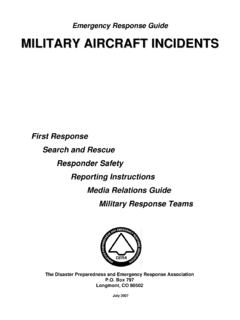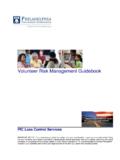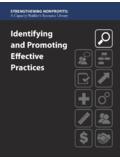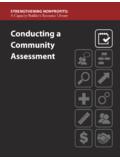Transcription of Introduction to CBRNE Terrorism - disasters.org
1 IInnttrroodduuccttiioonn ttoo CCBBRRNNEE TTeerrrroorriissmm An Awareness Primer and Preparedness Guide for Emergency Responders By Robert J. Heyer, Hazardous Materials Specialist Red Bank, New Jersey Email: January 10, 2006 Number Twenty in the DERA Monograph Series Published by The Disaster Preparedness and Emergency Response Association Box 797 Longmont, CO 80502 Introduction to CBRNE Terrorism : An Awareness Primer and Preparedness Guide for Emergency Responders By Robert J. Heyer, Number Twenty in the DERA Monograph Series Published by The Disaster Preparedness and Emergency Response Association Box 797, Longmont, CO 80502 Editor: Dennis I.
2 O'Quinn October 15, 2001; Revised April 7, 2003; January 10, 2006 ISSN 1521-1592 Copyright 2001, 2003, 2006, DERA International. This publication may not be reproduced in whole or in part without express prior permission of the Disaster Preparedness and Emergency Response Association, Inc. (DERA), Box 797, Longmont, Colorado, 80502 USA. Worldwide rights reserved. DERA and the DERA Logo are Trademarks ( } of the Disaster Preparedness and Emergency Response Association, Notice to academics, governmental agencies and nonprofit organizations: Permission to reprint this publication will normally be granted upon request.)
3 Fair Use Doctrine applies. You are welcome to quote portions of this document for research and educational purposes, provided credit is given to the author and a full reference citation is included in your bibliography/works cited. All commercial use requires prior approval. Address questions or inquiries to: Views and opinions expressed in this document are those of the author and do not necessarily represent DERA or other organizations or persons mentioned in this publication. Information presented herein, although believed to be accurate, is intended only for professional and academic consideration.
4 Neither DERA, the author, nor the editors assume any liability resulting from the use of this information, nor for its accuracy or completeness. Table of Contents Topic Page 1 Conventional Weapons and 2 Nuclear and Radioactive 3 Chemical 3 Biological 4 Handling Suspicious 4 Emergency 5 Self Protection for 6 Establishing an Emergency Command 7 General Safety 8 Early Indicators of 8 Likely 9 Conclusion and 9 Table of Properties for Major Chemical and Biological 10
5 DERA Mission Statement and Membership 11 IInnttrroodduuccttiioonn ttoo CCBBRRNNEE TTeerrrroorriissmm An Awareness Primer and Preparedness Guide for Emergency Responders By Robert J. Heyer, Red Bank, New Jersey Introduction As demonstrated recently, even small groups of individuals have the ability to cause massive damage and extensive human suffering with little or no warning. Predictably, firefighters, police officers, EMS personnel, and civilian volunteers will respond and be on the scene moments after any attack occurs. For such events in the future, however, rescue and treatment of victims and control or containment of fire and other hazards will be greatly complicated by the fact that the site may also be contaminated with nuclear, chemical, biological or radiological substances that pose an immediate threat to the health and safety of the emergency responders.
6 Also, the immediate impact of such attacks may reach much further than the scene of the disaster. Thousands of injured and potentially contaminated victims may depart the scene, returning to the suburbs and satellite cities where they reside, or privately seeking medical assistance. Emergency responders in metropolitan areas and far beyond will need to move quickly to deal with this predictable exodus from cities following any attack. This primer is an Introduction to the types of weapons first responders may be exposed to in a terrorist attack. Responders need to be ready to deal with any possible situation quickly, efficiently and professionally.
7 Knowledge of Chemical, Biological, Radiological, nuclear and Explosive weapons ( CBRNE ) is needed for every first responder. This paper is intended to provide an awareness-level Introduction to the subject for first responders and community officials. The intention of this paper is to give responders and those managing community emergency programs enough basic information to safeguard themselves and those for whom they are responsible. This material should also be suitable for use as talking points for public information officers and those training or educating volunteer organizations or the general public.
8 This information in this paper is not sufficient to prepare responders to work in contaminated areas. Those workers require training at the Operations, Technician and higher levels. With proper awareness and preparedness, we can save lives and reduce the impact of any potential terrorist attack. 1 Dr. Heyer is a biologist with extensive field experience in emergency response, hazardous materials situation management, bioenvironmental protection, infection control, radiological protection and respiratory protection. He is currently a Captain with the Red Bank (New Jersey) Fire Department, and was assigned as a decontamination operations manager for two field teams supporting evacuees and first responders from the World Trade Center disaster operations on September 11, 2001.
9 He may be contacted via Email at: - 1 - What types of weapons might be used? Terrorists potentially have a wide range of available weapons, ranging from very simple to exceedingly complex. With knowledge, preparation and training, first responders can safely deal with the consequences of each. In general, terrorist weapons can be categorized into four major types. It is important to remember that different types of weapons can be combined or used sequentially. Terrorist weapons are often referred to as weapons of mass destruction (WMD) because of the ability to kill large numbers of people.
10 The four categories of weapons are: 1. Conventional Weapons & Explosives. 2. Nuclear and Radioactive Weapons. 3. Chemical Weapons. 4. Biological Weapons. Conventional Weapons and Explosives The most likely type of terrorist weapon is a conventional explosive device. Some of these conventional weapons pack a very powerful punch and can bring down large buildings. The casualties could number in the hundreds in this type of attack. One example of this type weapon was the fuel oil-fertilizer bomb used to attack the Murrah Federal Building in Oklahoma City. First responders should be alert to the potential for structure collapse as well as secondary explosive devices in the area.




